Heraldic Tinctures: Difference between revisions
m →Proper |
mNo edit summary |
||
| (19 intermediate revisions by the same user not shown) | |||
| Line 4: | Line 4: | ||
The metals are Or and Argent, representing gold and silver respectively, although in practice they are often depicted as yellow and white. As a general rule of Heraldic Design, do not put Metals on Metals or Colors on Colors (rule of tincture). The names of the Colours and Metals are derived from Norman French. | The metals are Or and Argent, representing gold and silver respectively, although in practice they are often depicted as yellow and white. As a general rule of Heraldic Design, do not put Metals on Metals or Colors on Colors (rule of tincture). The names of the Colours and Metals are derived from Norman French. | ||
<center> | |||
{| class="wikitable" | {| class="wikitable" | ||
|- | |- | ||
| Line 23: | Line 23: | ||
| <center>White or Silver || <center>Yellow or Gold || <center>Blue || <center>Red || <center> Purple/Violet || <center> Black || <center> Green | | <center>White or Silver || <center>Yellow or Gold || <center>Blue || <center>Red || <center> Purple/Violet || <center> Black || <center> Green | ||
|} | |} | ||
</center> | |||
[[File:Arms of Caid - Colored Diapered and Outlined.jpg|400px|right|thumb|<center> Arms of [[Caid]]]] | |||
==Stains== | ===Stains=== | ||
Stains (stainand colours or staynard colours): are generally not used in SCA Heraldry. In medieval heraldry, the use of a stain represented a less-than honorable augmentation (abatement or rebatement) imposed by an heraldic authority or by royal decree for misconduct (there is some historical debate on this). These colours include: | Stains (stainand colours or staynard colours): are generally not used in SCA Heraldry. In medieval heraldry, the use of a stain represented a less-than honorable augmentation (abatement or rebatement) imposed by an heraldic authority or by royal decree for misconduct (there is some historical debate on this). These colours include: | ||
* Murrey: Deep mulberry-coloured, or reddish | * Murrey: Deep mulberry-coloured, or reddish purple (darker than Purpure). | ||
* Sanguine: Blood-red (darker than Gules) | * Sanguine: Blood-red (darker than Gules) | ||
* Tenné (tawny): orange-tawny colour, though orange is considered distinct in continental European and African heraldic traditions. | * Tenné (tawny): orange-tawny colour, though orange is considered distinct in continental European and African heraldic traditions. | ||
===Hatching and Tricking=== | |||
The use of hatching to illustrate heraldic tinctures is late-period, and was developed by <i>Jan Baptist Zangrius </i> (died 1606) and further developed by <i>Silvestro de Petra Sancta,</i> in 1638, to facilitate printing on the relatively recently developed printing press. Hatching was sometimes used in the SCA when color Xeroxing was not available. It is no longer in general use in the SCA. Before the use of hatching to depict individual heraldic tinctures, it was common to <i>"trick"</i> heraldic designs when colours were unavailable. The arms were drawn in outline, and the tinctures were written in abbreviated form. When submitting heraldic art to the SCA College of Heralds, a Black & White outline version is always requested along with a colour version. | |||
===Diapering=== | |||
Diapering is the optional decorating of large areas of flat colour by drawing crosshatches or arabesques in the illustration of arms (right). Diapering does not affect the blazon (heraldic description) and artistic license is allowed. | |||
==Furs== | ==Furs== | ||
In earlier period, there were only two furs, ermine and vair. Ermine represents the fur of the stoat (Mustela erminea), a type of weasel, in its white winter coat, when it is called an ermine. Vair represents the winter coat of the red squirrel (Sciurus vulgaris), which is blue-grey above and white below. There are examples of other "furs" but these are the most commonly used in SCA Heraldry. | In earlier period, there were only two furs, ermine and vair. Ermine represents the fur of the stoat (Mustela erminea), a type of weasel, in its white winter coat, when it is called an ermine. Vair represents the winter coat of the red squirrel (Sciurus vulgaris), which is blue-grey above and white below. There are examples of other "furs" but these are the most commonly used in SCA Heraldry. | ||
<center> | |||
{| class="wikitable" | {| class="wikitable" | ||
|- | |- | ||
| Line 43: | Line 51: | ||
| colspan=4 style="text-align: center;" | Colours may vary|| Colours as Shown || Colours as Shown || Colours as Shown || Colours as Shown || Colours may vary | | colspan=4 style="text-align: center;" | Colours may vary|| Colours as Shown || Colours as Shown || Colours as Shown || Colours as Shown || Colours may vary | ||
|} | |} | ||
</center> | |||
==Proper== | ==Proper== | ||
| Line 50: | Line 59: | ||
[[Category:Articles]] | [[Category:Articles]] | ||
[[Category: Herald]] | |||
Latest revision as of 13:19, 10 January 2024
Heraldic Tinctures: Tincture is the limited palette of colors and patterns used in heraldry. They are classified as metals, colours, or furs.
Colours and Metals
The metals are Or and Argent, representing gold and silver respectively, although in practice they are often depicted as yellow and white. As a general rule of Heraldic Design, do not put Metals on Metals or Colors on Colors (rule of tincture). The names of the Colours and Metals are derived from Norman French.
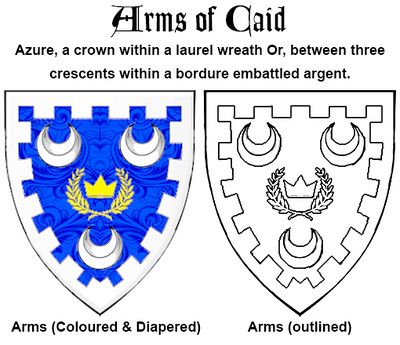
Stains
Stains (stainand colours or staynard colours): are generally not used in SCA Heraldry. In medieval heraldry, the use of a stain represented a less-than honorable augmentation (abatement or rebatement) imposed by an heraldic authority or by royal decree for misconduct (there is some historical debate on this). These colours include:
- Murrey: Deep mulberry-coloured, or reddish purple (darker than Purpure).
- Sanguine: Blood-red (darker than Gules)
- Tenné (tawny): orange-tawny colour, though orange is considered distinct in continental European and African heraldic traditions.
Hatching and Tricking
The use of hatching to illustrate heraldic tinctures is late-period, and was developed by Jan Baptist Zangrius (died 1606) and further developed by Silvestro de Petra Sancta, in 1638, to facilitate printing on the relatively recently developed printing press. Hatching was sometimes used in the SCA when color Xeroxing was not available. It is no longer in general use in the SCA. Before the use of hatching to depict individual heraldic tinctures, it was common to "trick" heraldic designs when colours were unavailable. The arms were drawn in outline, and the tinctures were written in abbreviated form. When submitting heraldic art to the SCA College of Heralds, a Black & White outline version is always requested along with a colour version.
Diapering
Diapering is the optional decorating of large areas of flat colour by drawing crosshatches or arabesques in the illustration of arms (right). Diapering does not affect the blazon (heraldic description) and artistic license is allowed.
Furs
In earlier period, there were only two furs, ermine and vair. Ermine represents the fur of the stoat (Mustela erminea), a type of weasel, in its white winter coat, when it is called an ermine. Vair represents the winter coat of the red squirrel (Sciurus vulgaris), which is blue-grey above and white below. There are examples of other "furs" but these are the most commonly used in SCA Heraldry.
| Vair | Counter-Vair | Potent | Counter-Potent | Ermine | Ermines | Erminois | Pean | Papellone |
|---|---|---|---|---|---|---|---|---|
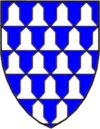 |
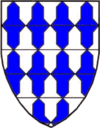 |
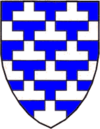 |
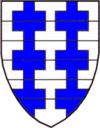 |
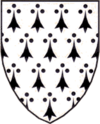 |
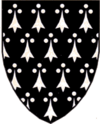 |
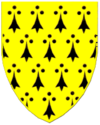 |
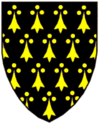 |
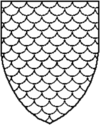
|
| Colours may vary | Colours as Shown | Colours as Shown | Colours as Shown | Colours as Shown | Colours may vary | |||
Proper
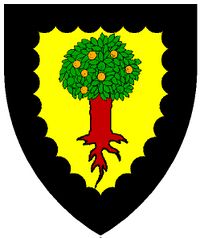
Or, an orange tree fructed and eradicated proper within a bordure invected sable.
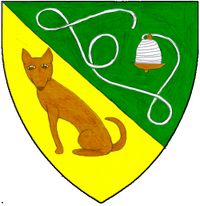
Per bend vert and Or, a wooden drop spindle proper threaded argent and a brown dog sejant guardant proper.
A charge that is coloured as it naturally appears is blazoned proper (Fr. propre), or "the colour of nature". An example would be, "an orange tree fructed and eradicated proper," (left). Objects that do not occur in nature may not be described as "proper," such as a dragon or wyvern, and must be described by colour. Natural objects which might naturally be of different colours may be further described to clarify the colour of the charge such as a "wooden drop spindle, proper, threaded argent" or a "brown dog" proper, (right).



